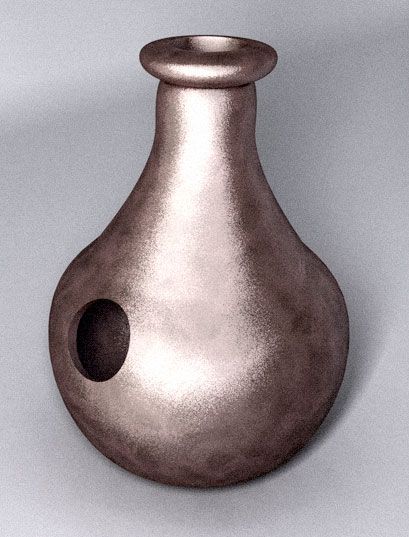
Udu, an Igbo instrument
The Igbo people have a melodic and symphonic musical style, which they designed from forged iron. Other instruments include opi otherwise known as Oja|5116] a wind instrument similar to the flute, igba, and ichaka.!?1
Another popular musical form among Igbo people is highlife, which is a fusion of jazz and traditional music and widely popular in West Africa. The modern Igbo highlife is seen in the works of Prince Nico Mbarga, Dr Sir Warrior, Oliver De Coque, Bright Chimezie, Celestine Ukwu and Chief Osita Osadebe, who are some of the greatest Igbo highlife musicians of the twentieth century. There are also other notable Igbo highlife artists, like the Mike Ejeagha, Paulson Kalu, Ali Chukwuma, Ozoemena Nwa Nsugbe.
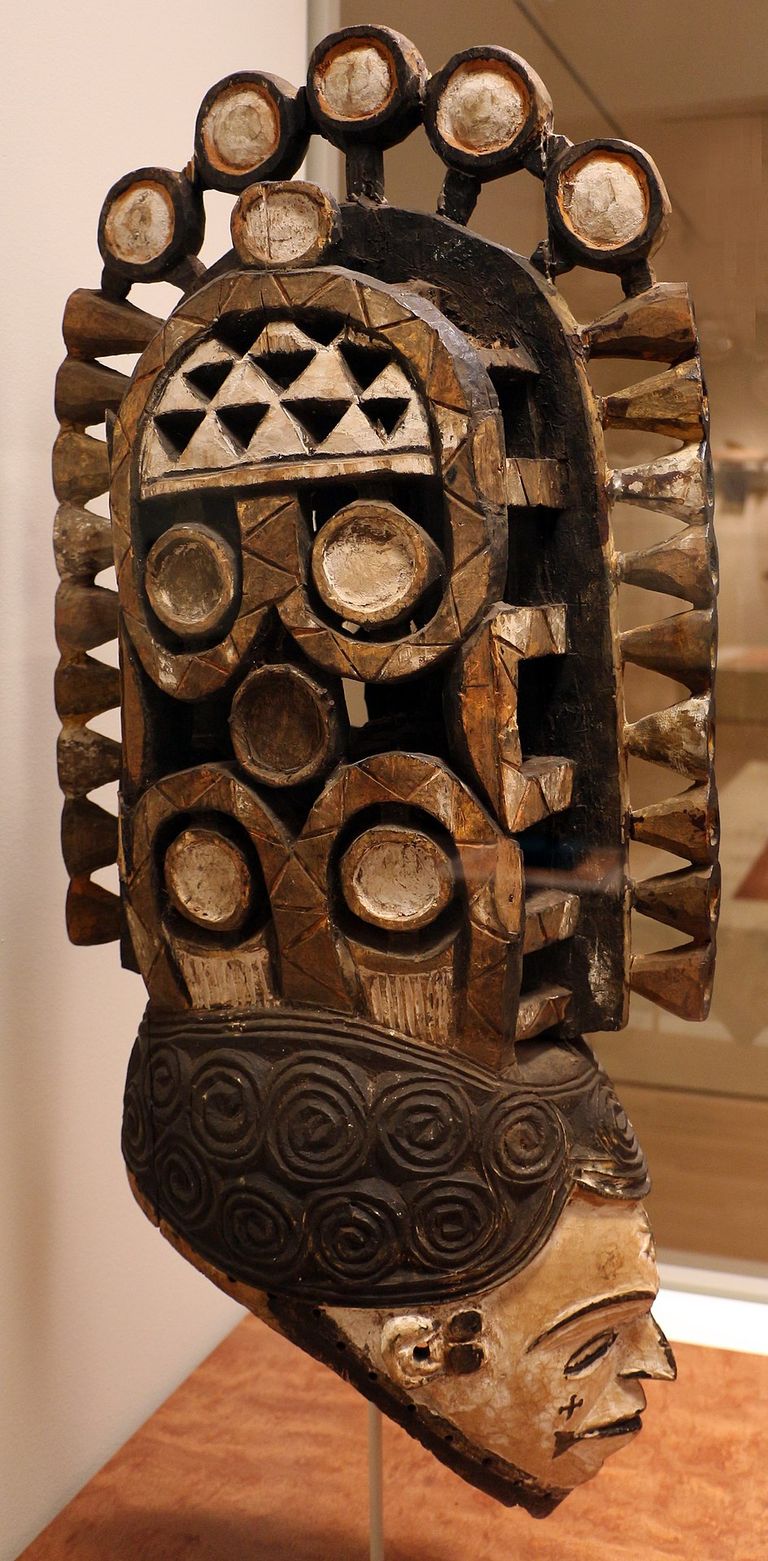
Igbo art
Igbo Art is known for various types of masquerade, masks and outfits symbolizing people, animals or abstract conceptions. Igbo art is also known for its bronze castings found in the town of Igbo Ukwu from the 9th century.
[8]
Igbo art is any body of visual art that originates from Igbo people. Igbo culture is a visual art and culture.

Female figure for a small temple, 20th century;
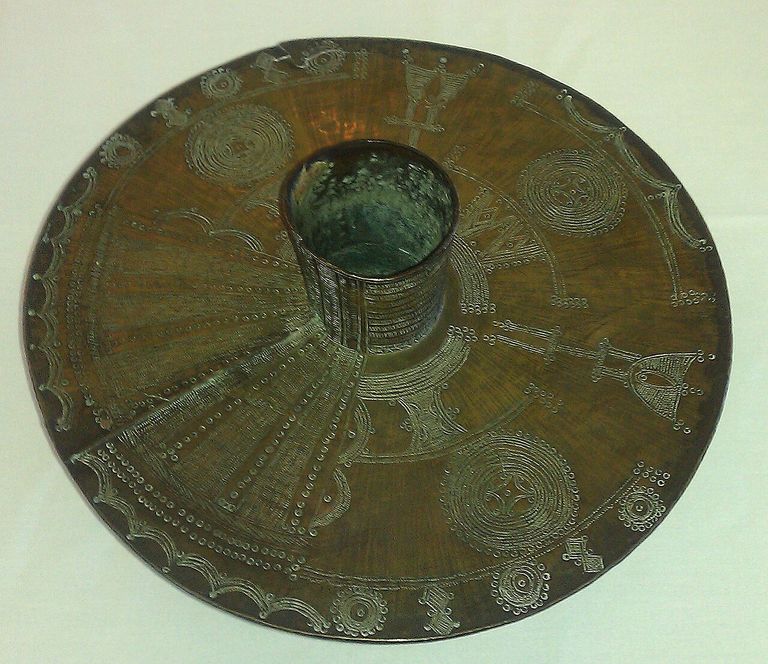
Anklet beaten from a solid brass bar of the type worn by Igbo women.
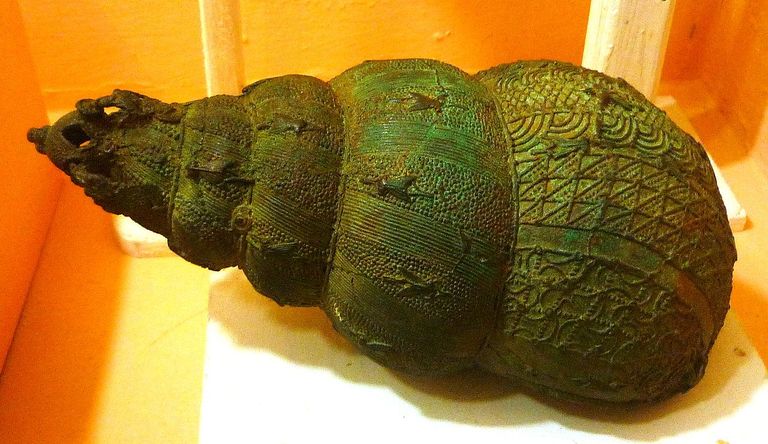
Bronze ceremonial vessel in form of a snail shell;
9th century;
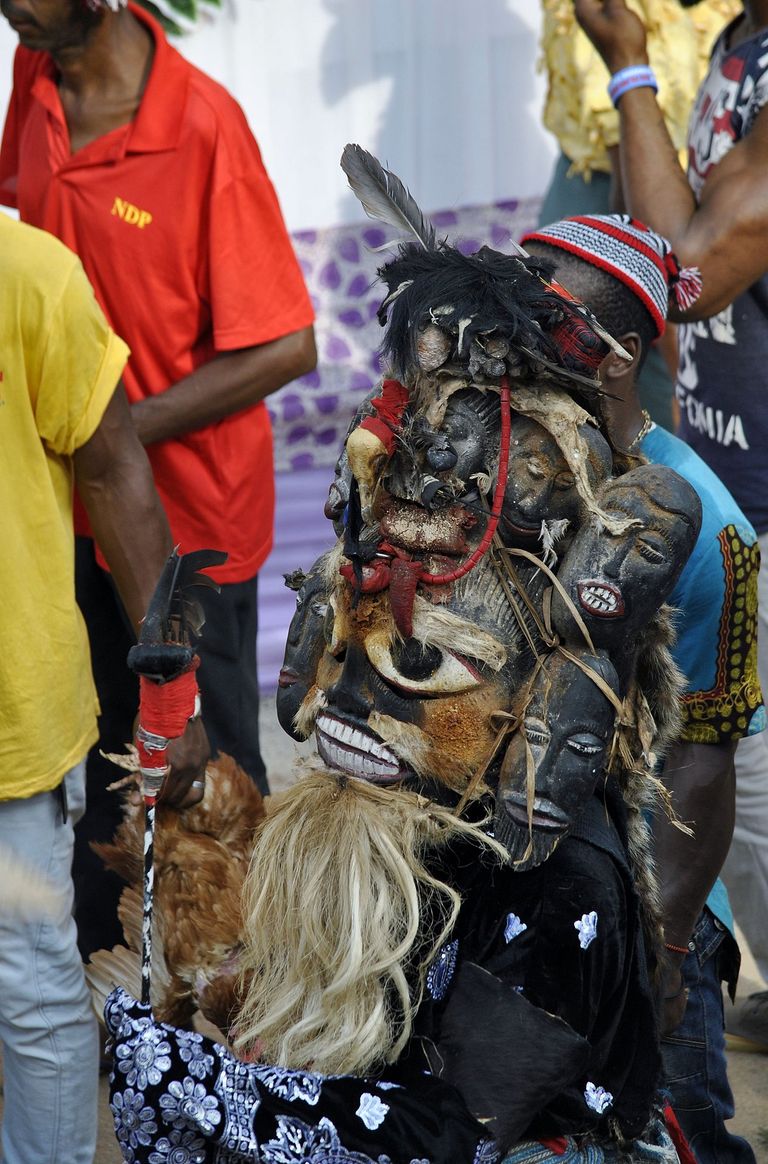
Eze Onyiudo Masquerade Awka-Etiti
While today many Igbo people are Christian, the traditional ancient Igbo religion is known as Odinani. In the Igbo mythology, which is part of their ancient religion, the supreme God is called Chineke ("the God of creation");
Chineke created the world and everything in it and is associated with all things on Earth. To the ancient Igbo, the cosmos is divided into four complex parts:[11]
• Okike (Creation)
• Alusi (Supernatural Forces or Deities)
• Mmuo (Spirit)
• Uwa (World)
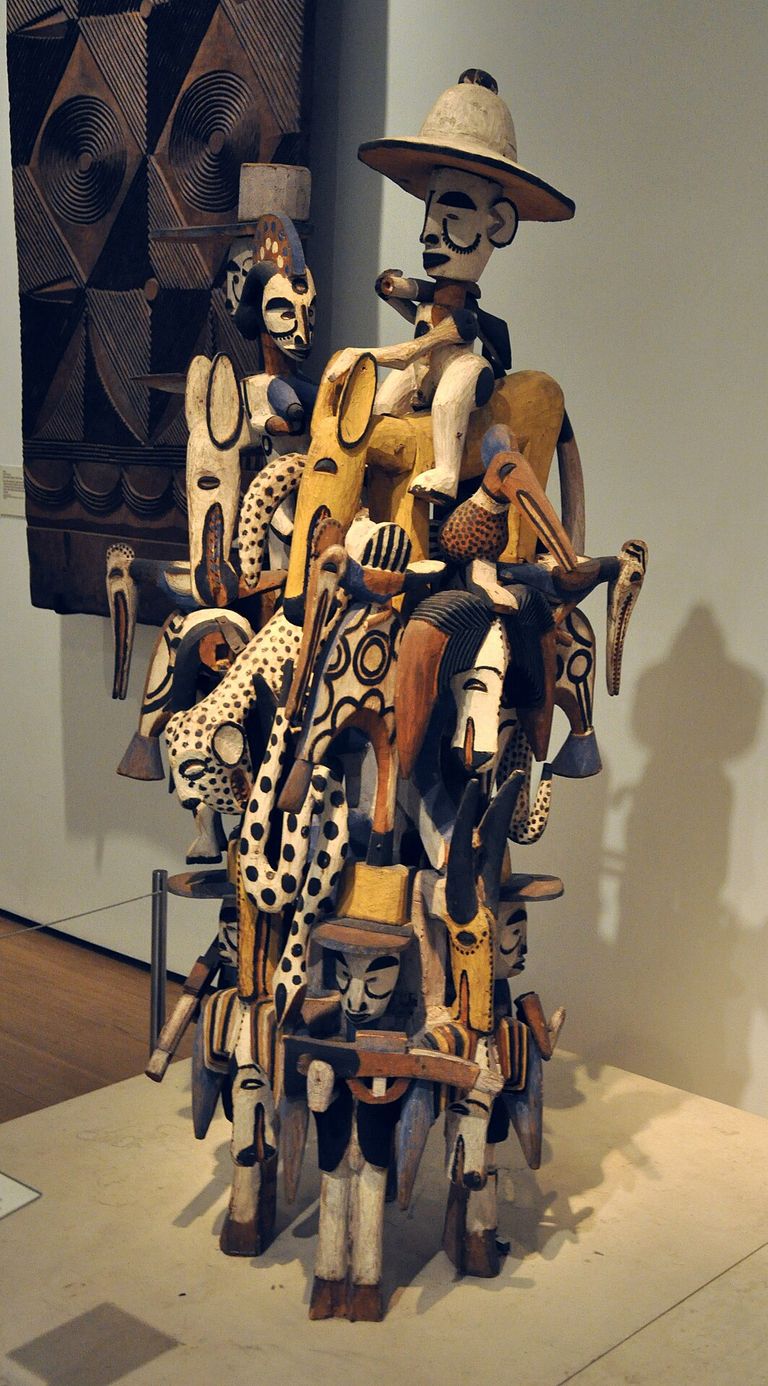
Alusi
Alusi, also known as Arusi or Arushi, are minor deities that are worshiped and served in Igbo mythology. There are a list of many different Alusi that exists within each
community and each has its own purpose.
When there is no longer need for the deity, it is returned to its source, through the help of a Chief Priest or Dibia, who is aware of the procedure and ensures that its done properly.
Mmuo
Mmuo simply means spirit. It is either a good and godly spirit (mmuo oma) or it is an evil spirit (mmuo ojo). For example, the Ogbanje spirit is seen as an evil spirit (mmuo ojo) and anyone possessed by this spirit is given spiritual attention. (Spiritual attention means a way of casting out the evil spirit through deliverance (Christian way) or through African Traditional Religion (i.e. digging out his/her "iyi uwa". the ATR way)). Ogbanje is an Igbo (Nigeria) term that means a repeater or someone who comes and departs. 13. Ogbanje is not a bad spirit in Igbo Cosmology. It is a word widely used to describe a kid or teenager who is claimed to die and be born repeatedly by the same person.
Yam
The yam is very important to the Igbo as it is their staple crop. There are celebrations such as the New yam festival (Igbo: Iri Ji) which are held for the harvesting of the yam.[14]
The New Yam festival (Igbo: Iri ji) is celebrated annually to secure a good harvest of the staple crop. The festival is practiced primarily in Nigeria and other countries in West Africa.
Traditional marriage
Marriages in Igbo community follow a multi-step process before the bride and groom are proclaimed husband and wife in accordance with local law and tradition.[16]
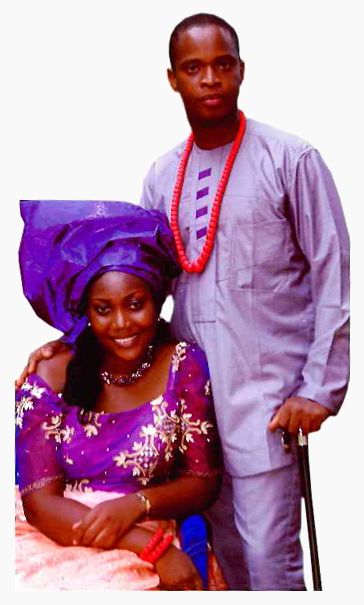
The traditional marriage is known as Igbankwu, or wine carrying, since it involves the bride serving up a cup of palm wine to her fiancé.
Prior to the wedding, the groom must go to the bride's compound with his father before the Igbankwu day to get the bride's father's consent to marry her daughter. If the bride's father is late, in this case, the bride's brother, uncle or male relative fills in for the bride's late
father, as applies to the groom. On the second visit, when kola nuts (oji Igbo) are offered, the two fathers must arrange a price for the bride.
' In most cases, the bride's price is just symbolic, in addition to other requirements like kola nuts, goats, wine, fowl and so on.
Normally, it takes more than one evening until the ultimate bride's price is agreed upon, after which a feast is served to both parents. When the bride price is paid, another evening is set aside for the ceremony.(17]
During the ceremony, the bride's father fills a cup with palm wine and hands it over to the daughter. She then searches for the groom among the crowd of wedding guests to offer him the drink. Once the drink is offered, the bride and groom dance to the bride's father.
They kneel before him and he will gives them his blessings. After that, the couple dances for a while before taking their seats, then refreshment takes place followed by presentation of gifts, at times a speech from the MC, and then closing prayer and departure.
Igbo architecture
refers to the architectural styles and building traditions of the Igbo people. The architectural style is closely tied to the Igbo society's culture, beliefs, and social structure. While the architectural style has
evolved, traditional Igbo architecture shares some common characteristics such as:
Compound layout-
Igbo architectural traditions often revolve around the concept of a compound which is characterized by an enclosed area encompassing multiple family residences, open central courtyards, verandas, and auxiliary structures. These compounds are meticulously planned and sometimes paved with flat stones to foster communal living and facilitate familial engagements. Additionally, certain compounds feature unique elements like Impluvium houses, Gardens, Moats, and water wells demonstrating the diversity within Igbo architectural practices.
Ventilation -
Igbo architecture integrates strategic placement of openings in buildings to promote cross-ventilation, aiding in regulating indoor temperatures. Employing expansive openings facilitates air circulation, ensuring occupant comfort. Depending on the area with high temperatures and humidity, evaporation of sweat becomes challenging; however, airflow aids this process, enhancing comfort.
Moreover, construction practices involve thick walls, thatched roofs, and raised foundations to mitigate environmental challenges. The thick walls maintain cooler interiors in hot weather and warmth during rainy seasons. Thatched roofs provide insulation from direct sunlight, offering shade and contributing to thermal comfort.[18]
Shrines and Sacred Spaces-
Igbo architecture often includes designated spaces in compounds or community areas for ancestral shrines/temples and secret society meeting houses. These spaces are considered sacred and are an essential part of Igbo cultural and religious practices. These sacred structures may vary in design, ranging from simple open-air spaces to more elaborate structures with specific architectural features.
Decorative Elements -
Traditional Igbo architecture often incorporates decorative
elements, including painted designs on walls such as uli, carved wooden door frames, and intricate patterns on ceilings. These decorations may have symbolic or religious significance.[19]

Traditional attire
An Igbo man Of the Ochiogu Clan in his native attire
Traditionally the attire of the Igbo generally consisted of little clothing as the purpose of clothing then was to conceal private parts, although elders were fully clothed. [201 Children were usually nude from birth till their adolescence (the time when they were considered to have something to hide) but sometimes ornaments such as beads were worn around the waist for medical reasons. Uli body art was also used to decorate both men and women in the form of lines forming patterns and shapes on the body.
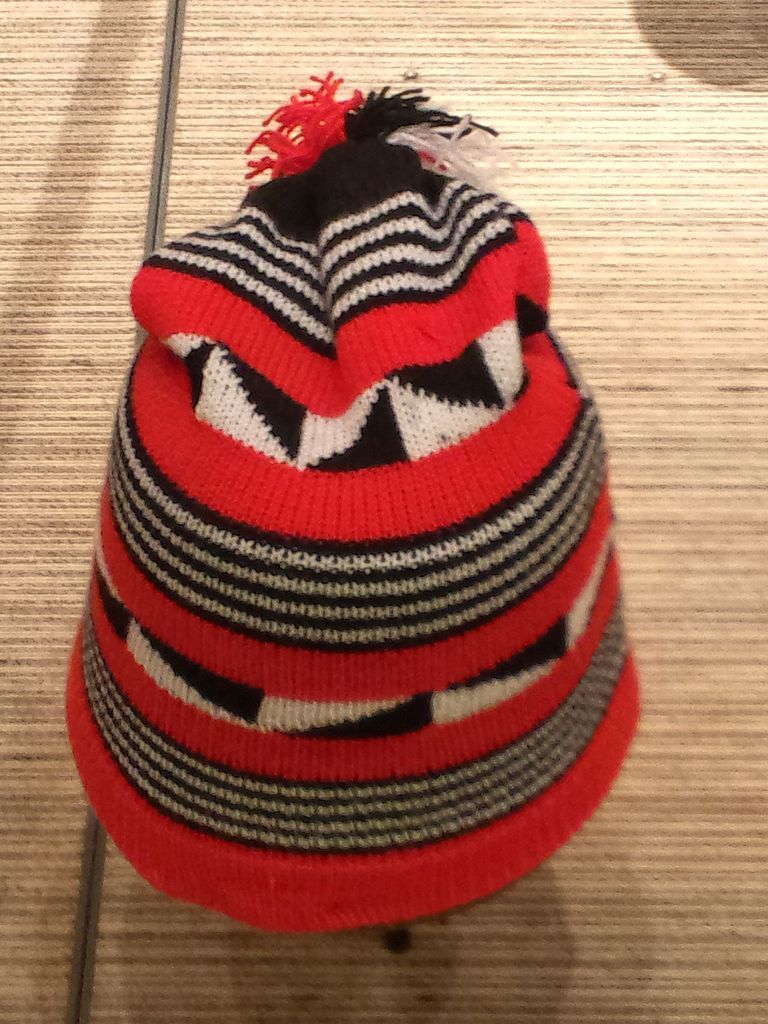
A traditional Igbo hat made entirely from
With colonialism and the Westernization of Igbo culture, Western styled clothes such as shirts and trousers over took traditional clothing.121]
Women
Women carried their babies on their backs with a strip of clothing binding the two with a knot at her chest. This baby carrying technique was and still is practiced by many people groups across Africa, including the Igbo. This method has been modernized in the form of the child carrier. In most cases, Igbo women did not cover their chest areas. Maidens usually wore a short wrapper with beads around their waist with other ornaments such as necklaces and beads.122] Both men and women wore wrappers.121]
MEN
Men would wear loin cloths that wrapped around their waist and between their legs to be fastened at their back, the type of clothing appropriate for the intense heat as well as jobs such as farming.!21 Men could also tie a wrapper over their loin cloth. For public occasions such as traditional weddings, men tie such materials like gorge, which is considered to be expensive, and this usually goes with'Isiagu' popular for wealthy and traditional title holders.
Modern traditional attire
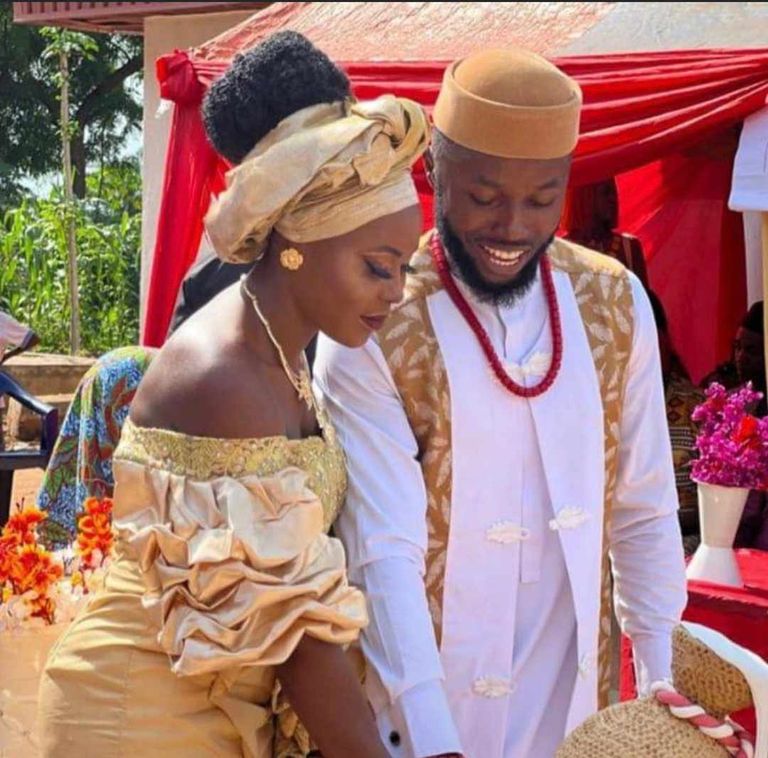
Igbo Traditional Marriage attire
Modern Igbo traditional attire is generally made up, for men, of the Isiagu top which resembles the African Dashiki. Isiagu (or Ishi agu) is usually patterned with lions heads embroidered over the clothing, It can also be plain, (usually black). It is worn with trousers and can be worn with either a traditional title holders hat (a fez named okpu agu or agwu), or with the traditional Igbo stripped men's hat (which resembles the Bobble hat). For women, an embodied puffed sleeve blouse (influenced by European attire) along with two wrappers (usually modern Hollandis material) and a head scarf are worn.
Chieftaincy Title
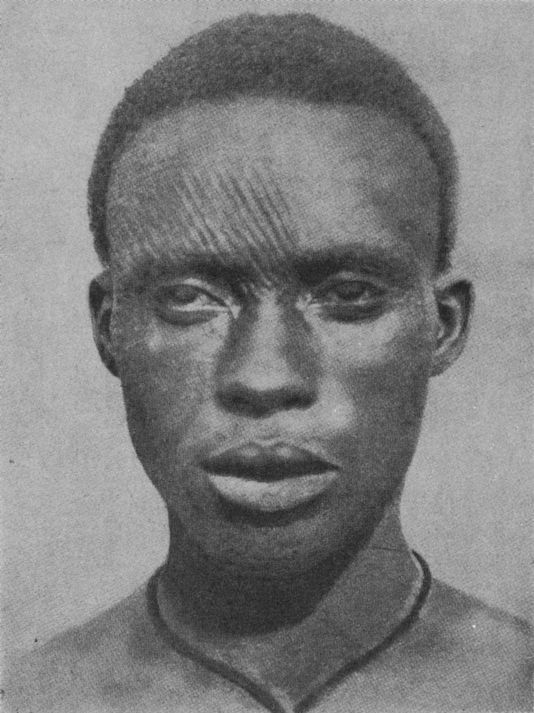
An Igbo man with Ichi marks, a sign of rank as an Ozo!23]
Highly accomplished men and women are admitted into their noble orders for people of
title such as Ndi Ozo or Ndi Nze. These people receive insignia to show their stature.
Membership is highly exclusive, and to qualify an individual need to be highly regarded and well-spoken of in the community.
Apprenticeship
The Igbo have a unique form of apprenticeship in which either a male family member or a
community member will spend time (usually in their teens to their adulthood) with another
family, when they work for them. After the time spent with the family, the head of the host household, who is usually the older man who brought the apprentice into his household, will establish (Igbo: idu) the apprentice by either setting up a business for him or giving money or tools by which to make a living. [24]
This practice was exploited by Europeans, who used this practice as a way of trading in enslaved people. Olaudah Equiano, although stolen from his home, was an Igbo person who was forced into service to an African family. He said that he felt part of the family, unlike later, when he was shipped to North America and enslaved in the Thirteen Colonies.[25]
The Igbo apprenticeship system 26. is called Imu Ahia or Igba Boy in Igboland which became more prominent in among the Igbos After the Nigerian civil war. In a quest to survive the £20 policy which was proposed by Obafemi Awolowo that only £20 be given to every Biafran citizen to survive on regardless of what they had in the bank before the war and the rest of the money were held by the Nigerian government.
Petty trade was one of the only ways to build back destroyed communities as well as Farming, but then, farming required time that was not readily available at that moment.
Basically, most people went into trading. [27]
This Imu-Ahia/lgba Boy model was simple, it works in such a way that business owners would take in younger boys which can be relative, sibling or non-relative from same region, house them and have them work as apprentices in business while learning how it works and the secrets of the business. After the allotted time for the training was reached,
5-8 years' time, a little graduation ceremony would be held for the Nwa Boy (the personrest of the money were held by the Nigerian government.
Petty trade was one of the only ways to build back destroyed communities as well as Farming, but then, farming required time that was not readily available at that moment.
Basically, most people went into trading. [27]
This Imu-Ahia/lgba Boy model was simple, it works in such a way that business owners would take in younger boys which can be relative, sibling or non-relative from same region, house them and have them work as apprentices in business while learning how it works and the secrets of the business. After the allotted time for the training was reached,
5-8 years' time, a little graduation ceremony would be held for the Nwa Boy (the person that learnt the trade). He would also be paid a lump sum for their services over the years, and the money will be used to start a business for the Nwa Boy.128]
Osu caste system
Osu are a group of people whose ancestors were dedicated to serving in shrines and temples for the deities of the Igbo, and therefore were deemed property of the gods.
Relationships and sometimes interactions with Osu were (and to this day, still are) in many cases, forbidden.
To this day being called an Osu remains a stigma that prevents people's progress and lifestyles. 129]
Calendar (Iguafo Igbo)
In the traditional Igbo calendar, a week (Igbo:
Izu) has 4 days (Igbo: Ubochi) (Eke, Orie, Afo, Nkw.), seven weeks make one month (Igbo:
Onwa), a month has 28 days and there are 13 months in a year. In the last month, an extra day is added. 30. The names of the days have their roots in the mythology of the Kingdom of Nri. It was believed that Eri, the sky-born founder of the Nri kingdom, had gone on a journey to discover the mystery of time. On his journey he had saluted and counted the four days by the names of the spirits that governed them, and so the names of the spirits (eke, orie, afo and Nkwo) became the days of the week.131]
No.
Months (Onwa)
Gregorian equivalent
1
Onwa Mbụ
(3rd week of February)
2
Onwa Abụa
(March)
3
Onwa Ife
Eke
(April)
4
Onwa Ano
(May)
5
Onwa Agwน
(June)
6
Onwa
Ifejioku
(July)
7
Onwa Alom
Chi
(August to early
September)
8
Onwa llo
Mmụa
(Late September)
9
Onwa Ana
(October)
10
Onwa Okike
(Early November)
11
Onwa Ajana
(Late November)
12
Onwa Ede
Ajana
(Late November to December)
13
Onwa Uzo
Alusi
(January to early February)[32][33]
An example of a month: Onwa Mbụ
Eke Orie Afọ Nkwọ
1
2
3
4
5
6
7
8
9
10
11
12
13
14
15
16
17
18
19
20
21
22
23
24
25
26
27
28
Naming after market days
Newborn babies were sometimes named after the day of the week when born. This is no longer the fashion. Names such as Mgbeke (maiden [born] on the day of Eke), Mgborie (maiden [born] on the Orie day) are commonly seen among the Igbo people. For males, Mgbe is replaced by Nwa or "Okoro" (Igbo: Child [of]). Examples of this are Solomon Okoronkwo and Nwankwo Kanu, two popular
There are two basic types of masquerades, visible and invisible. The visible masquerades are meant for the public. They often are more entertaining. Masks used offer a visual appeal for their shapes and forms. In these visible masquerades, performances of harassment, music, dance, and parodies are acted out (Oyeneke 25).
The invisible masquerades take place at night.
Sound is the main tool for them. The masquerader uses his voice to scream so it may be heard throughout the village. The masks used are usually fierce looking and their interpretation is only fully understood by the society's members. These invisible
masquerades call upon a silent village to strike fear in the hearts of those not initiated into their society.
Thanks so much for stopping please comment if you find it interesting
Thanks to blurt to the moon ✈️✈️✈️🌖🌗